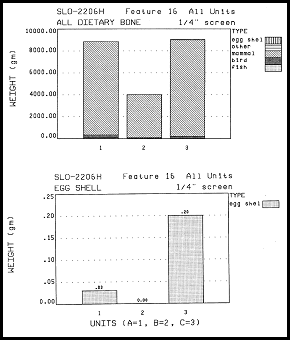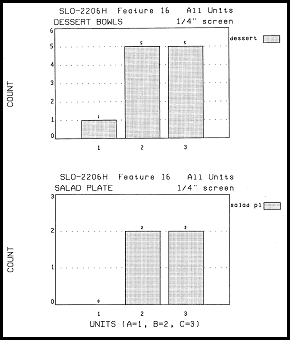Eating Materials Recovered












A large percentage of the materials recovered from the outhouse were kitchen and diet related items. These included plates, serving and eating utensils, bone, shell, and even organic items.
Graphs of the locations of various types of bone provide insight into the locations of eating activities. Most bone was mammal (beef, pork, etc.). Mammal bone was concentrated in Units A and C. Food related items were expected in Unit A, as this unit was closest to the kitchen/dinning building.
But why Unit C? It appears that the nuns and some of the patients in the infirmary preferred to take their meals in the Chapel building. This would explain the high weights of certain types of bone in Unit C (located closest to the Chapel building). This was true of mammal bone, eggshell (probably from hard boiled eggs), and bird bone (mostly chicken). However, fish bone was found almost exclusively in Unit A.
One possible explanation is that mammal and chicken meat can be cooked and eaten cold at a later time with no fear of spoilage. The same is true of eggs. Thus, these types of foods were more portable and likely to be transported from the kitchen to other locations for consumption. Fish does not fall into this category and was not a likely candidate for consumption away from the kitchen/dining area.
Organic Material 
Marine shellfish remains were also found in the privy vault. Although 15 species were represented, the most
abundant by weight was Pismo clam (tivela). The next most abundant by weight were oyster and cockle
(clinocardium). Both were popular shellfish in the early 20th century diet.
Organic material recovered included charcoal along with various seeds and pits. Most were recovered from
Unit A (near the kitchen area). Identifiable seeds included squash seeds, peach pits, cherry pits, and corncob pieces.
Flatware 
Eighteen pieces of flatware were recovered, including 3 table knives, 2 forks (three tine), 3 standard spoons,
one teaspoon, one serving spoon, one butter knife, and 6 handles missing the business ends. Flatware handles were of wood (6), steel (6), copper (5), and bone (1).
Also recovered was a rusty piece of metal that appeared to be the end of a frosting applicator.
Dinnerware 
Most dinnerware was of heavy utilitarian stoneware and cream ware. These plain white soup bowls and dinner plates were primarily found in Unit A (closest to the dining hall).
An exception to this trend is seen with dessert bowls and salad plates (see graphs at left). These appear to have been disposed of in the part of the privy closest to the Chapel building. As was seen with “portable” foods (such as eggshell and chicken bone) listed in the top graphs, it is possible that these smaller dishes were used, broken, and disposed of by patients in the infirmary or nuns located in the Chapel building.
Virtually all the fancy “Victorian” style wares were found in Unit C (closest to the Chapel building). This suggests an attempt by the nuns to bring a little of the “Victorian” style into their lives and further suggests that they ate in the Chapel building, separately from the students.
Chinese Ware 
It is interesting to note that a few pieces of Chinese porcelain and stoneware were also recovered. These included “Four Seasons” and polychrome condiment dishes, pieces of both blue and white and celadon rice bowls, pieces of food and liquor jars, a medicine vial, and large shipping jar that had been painted green and converted into a planter. A green abalone shell was still in place blocking the drilled drain hole inside the jar.
Most Chinese items were found in Unit A, (closest to the Kitchen/laundry area) suggesting that a Chinese person was employed for one or both of these activities.
Maker’s Marks
Marks represented wares from 20 different companies. The number of pieces from each suggest that pieces from the Thomas Furnival & Sons company were the most popular followed by John Maddock products, Johnson Bros., and J&G Meakin.
Some pottery marks are confined to just a few years of manufacture and can assist in determining the age of the deposit (years of privy use in this case). Obviously a piece of ceramic with a particular mark can be manufactured many years before it ends up broken in a trash pile. However, it can’t end up in a trash pit before its year of manufacture. Using this law and the span of years of each maker’s mark, brackets have been placed on this graph that represent the most likely span of years that the privy was in use. We know that the privy already existed in 1888. And the privy must have still been in use in 1906 to have contained a Maddock & Co. bowl.
| Pottery marks recovered and years of manufacture | # of Pieces | Reference |
| Powell & Bishop (1876-78) | 1 | Godden 1991:509 |
| Charles Meakin (1870-82) | 1 | Godden 1991:426 |
| Sebring Porcelain (1900) | 1 | Lehner 1988:414 |
| E. Walley ? questionable (1845-56) | 1 | Godden 1991:644 |
| W.H. Grindley & Co. (1891-1914) | 1 | Godden 1991:294 |
| A.J. Wilkinson Ltd. (1896) | 1 | Godden 1991:672 |
| K. T. & K. Warranted (1872-1904) | 1 | Lehner 1988:238 |
| K. T. & K. Granite (1872-1904) | 2 | Lehner 1988:239 |
| Henry Alcock & Co. (1891-1900) | 2 | Godden 1991:27 |
| John Edwards (1880-1900) | 2 | Godden 1991:231 |
| H. Burgess (1864-92) formerly T. & R. Boote | 2 | Godden 1991:116 |
| T. & R. Boote (1890-1906) | 2 | Godden 1991:84 |
| Wood & Son (1891-1907) | 3 | Godden 1991:689 |
| Edward Clarke (1865-77) | 3 | Godden 1991:147 |
| Thomas Hughes (1860-94) | 4 | Godden 1991:339 |
| John Maddock & Sons (1880-96) | 4 | Godden 1991:406 |
| Maddock & Co. (1906+) | 6 | Godden 1991:406 |
| J. & G. Meakin (1890+) | 7 | Godden 1991:427 |
| Johnson Bros. (1883-1913) | 7 | Godden 1991:335 |
| Thomas Furnival & Sons (1818-1890) | 19 | Godden 1991:263 |
| Davenport (1793-1887) | 1 | Godden 1991:189 |
Most likely period of use based on maker’s marks.

